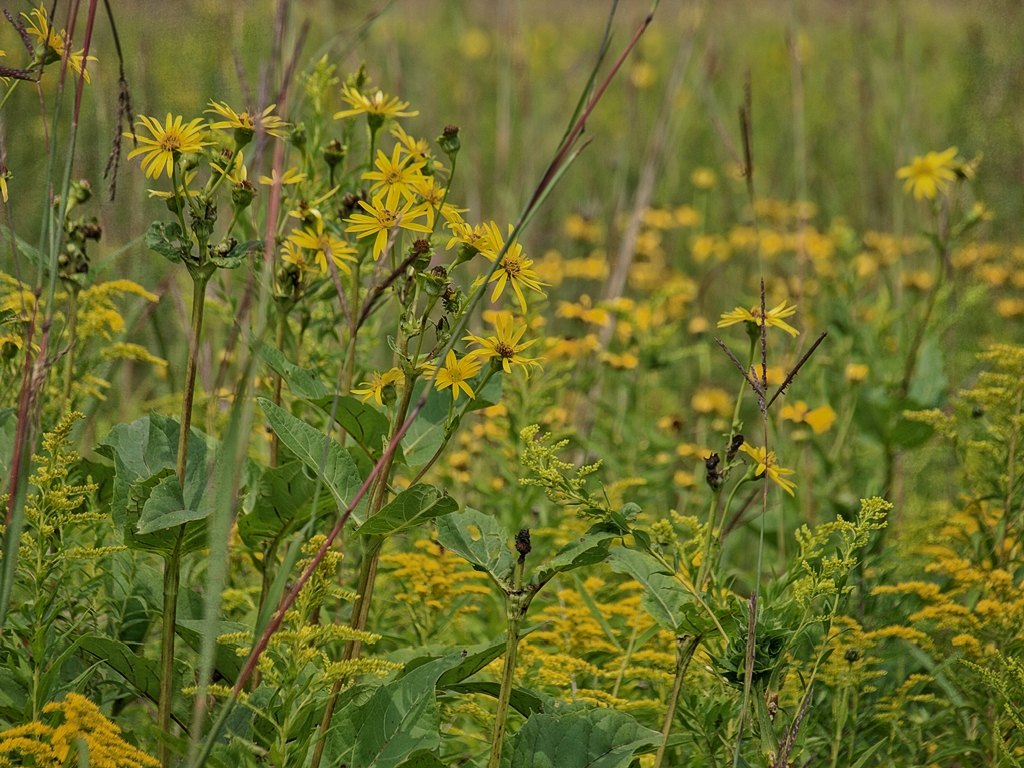
Cuppants (Silphium perfoliatum) flow into a sea of yellow Anise-scented goldenrod (Solidago odora), and orange coneflowers (Rudbeckia fulgida).
Once upon a time, there was a tall man named John Muir. He went for a walk through a prairie. Pretty soon, he came upon a small familiar looking lake. He whistled and, when no one answered, he sat down.

At the lake in the meadow, he spied three murky views into the future. John was a quirky curious fellow. He stared as the first hazy image became clearer.

Seedheads of Black-eyed Susans
“This image picture is so wrong!” he exclaimed. “Tis a very cold semblance to what I remember.”
Now on his knees, he gazed as the second vision cleared.

Tall thistle (Cirsium altissimum)
“This landscape is too contrived!” he said. “Nothing looks familiar to me.”

As the last swirl in the lake became clear he exclaimed, “Ah, this view is just right!”

Queen Anne’s Lace – pre-bloom
He happily sat back, crossed his hands behind his head, and recalled his boyhood.

Black-eyed Susan – skeletal remnant of July
After seeing the three visions John was feeling a wee little sleepy. Shuffling off to a hillside where he saw three trees, he leaned against the first tree to rest.

Monarda fistulosa (Wild Bergamot) – after the bloom has faded
“This tree is too hard!” he exclaimed.

So he leaned against the second tree.

“This tree is too small!” he growled.

Prairie Cinquefoil
He chose the third tree, a young Bur oak, where he sighed and fell into a deep slumber while listened to the rustling dried leaves, sounding like far off tinkling of bells in a Buddhist temple.

Ratibida pinnata (Yellow Coneflower)
As he was sleeping, three organization leaders came to discuss how to revive the worked-out land on which he slept.

Wind painting the Little Bluestem -Schizachyrium scoparium grass on the tall grass prairie
Papa bear, who owned the largest portion of the land, decided it would be seventy-five percent native wild flowers, with a smidgen of sedges, and a portion of four native grasses, keeping the upland hardwoods, and a plan to open walking paths. This would become the John Muir County Park.

Wind painting with Big Bluestem grass, staple of the tall grass prairie
Mama bear, who owned the original homestead, the actual site of the Muir family house over looking the lake (NOTE: Private property no public access) felt the original prairie land would have been mostly grass with a smidgen of prairie flowers. They have maintained their property as predominately short grass prairie with appropriate prairie plants. I think John would easily recognize his front yard.

Wind painting the sedges and various grasses of the tall grass prairie
The federal government’s taken half the Muir family’s original homestead property and turned it into a tall grass prairie. Severed as cleanly by Wisconsin’s Marquette County Highway F, the Fox River National Wildlife Refuge, is a gem of a prairie reconstruction. Don’t visit Muir County Park and not cross the road to stand amid the waving grasses of a different kind of reconstructed environment.

Wind painting the tall grass prairie …
On a windy day you’ll understand why pioneer ancestors referred to their wagons as ‘prairie schooners’. The wind tosses waves of color, sunlight foams, and textures flow across my vision. Is it wind blowing past my ear or faint murmurs as John Muir and his boyhood friends scurry toward the distant river.

Wind painting a close in view of the neon, late August colors, of Big Bluestem prairie grass.
Would John Muir recognize any of the three landscapes? Which would look the most familiar to him? If an award were given for best adaptation, which of the three would receive it? I know which I prefer, and I know which I like least. Not that I would exclude any from my visits or my camera. All have something to discover, to teach, to preserve. Which to consider correct, I’ll leave for wiser minds than mine.
![Wind painting the tall grass prairie dominated by Big bluestem, Turkeyfoot, Indiangrass [Sorghastrum nutans], Switchgrass [Panicum virgatum], and Little Bluestem [Schizachyrium scoparium]), and lively yellow of Solidago speciosa (Showy Goldenrod).](https://theroadlesspaved.com/wp-content/uploads/2014/08/fw180779ablog.jpg?w=640&h=480)
Wind painting the tall grass prairie dominated by Big bluestem, Turkeyfoot, Indiangrass [Sorghastrum nutans], Switchgrass [Panicum virgatum], and Little Bluestem [Schizachyrium scoparium]), and lively yellow of Solidago speciosa (Showy Goldenrod).
(Unfortunately, I haven’t visited the private property – original home site in over ten years, so I have no current photos or permissions to post. You’ll have to trust me … it’s spectacular.)For information on where location and travel to Wisconsin’s John Muir country visit
http://www.marquettenow.com/bike4trail.php

























![Wind painting the tall grass prairie dominated by Big bluestem, Turkeyfoot, Indiangrass [Sorghastrum nutans], Switchgrass [Panicum virgatum], and Little Bluestem [Schizachyrium scoparium]), and lively yellow of Solidago speciosa (Showy Goldenrod).](https://theroadlesspaved.com/wp-content/uploads/2014/08/fw180779ablog.jpg?w=640&h=480)